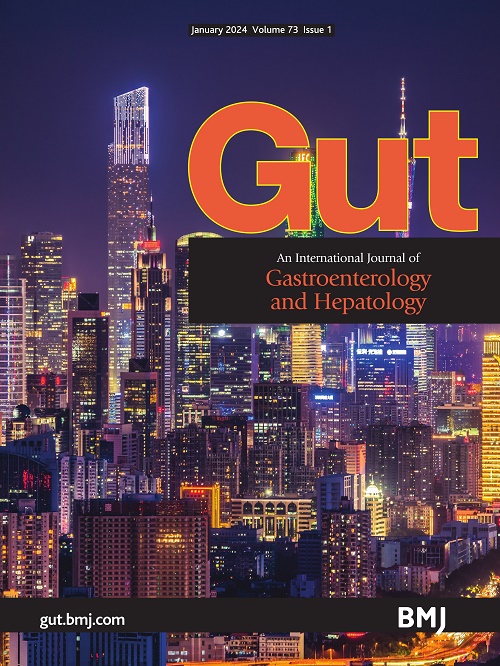代谢功能障碍相关性脂肪肝患者使用钠-葡萄糖共转运体-2 抑制剂、胰高血糖素样肽-1 受体激动剂和噻唑烷二酮类药物引发肝病的风险
IF 25.8
1区 医学
Q1 GASTROENTEROLOGY & HEPATOLOGY
引用次数: 0
摘要
目的 通过与胰高血糖素样肽-1受体激动剂(GLP-1RA)或噻唑烷二酮类药物(TZD)进行正面比较,研究钠-葡萄糖共转运体-2抑制剂(SGLT-2i)对代谢功能障碍相关性脂肪性肝病(MASLD)患者的肝脏疗效。设计 这项基于人群的队列研究是利用韩国全国范围内的医疗索赔数据库(2014-2022 年)进行的。我们纳入了开始服用 SGLT-2i 或对比药物(GLP-1RA 或 TZD)的 MASLD 患者(年龄≥40 岁)。主要结果是肝功能失代偿事件的复合结果,包括腹水、食道静脉曲张伴出血、肝功能衰竭或肝移植。肝病死亡和全因死亡也作为次要结果进行评估。采用 Cox 比例危险模型估算 HR 值及 95% CI。结果 经过1:1倾向评分匹配后,我们纳入了22 550名开始使用SGLT-2i和GLP-1RA的患者(中位年龄=57岁,60%为男性),以及191 628名开始使用SGLT-2i和TZD的患者(中位年龄=57岁,72%为男性)。与 GLP-1RA 相比,SGLT-2i 发生肝功能失代偿事件的风险相似(HR 0.93,95% CI 0.76 至 1.14)。与 TZD 相比,SGLT-2i 发生肝功能失代偿事件的风险更低(HR 0.77,95% CI 0.72 至 0.82)。与 TZD 相比,二次分析结果显示,按性别分层后,SGLT-2i 的肝功能失代偿事件风险显著降低(男性:HR 0.87(95% CI 0.80-0.94);女性:HR 0.62(95% CI 0.55-0.69))。结论 在这项全国性队列研究中,与 TZD 相比,SGLT-2i 可降低 MASLD 患者发生肝功能失代偿事件的风险,同时与 GLP-1RA 的疗效相似。暂无数据。通讯作者将应要求提供该研究的数据。本文章由计算机程序翻译,如有差异,请以英文原文为准。
Risk of hepatic events associated with use of sodium-glucose cotransporter-2 inhibitors versus glucagon-like peptide-1 receptor agonists, and thiazolidinediones among patients with metabolic dysfunction-associated steatotic liver disease
Objective To examine the hepatic effectiveness of sodium-glucose cotransporter-2 inhibitors (SGLT-2i) through a head-to-head comparison with glucagon-like peptide-1 receptor agonists (GLP-1RA) or thiazolidinediones (TZD) in patients with metabolic dysfunction-associated steatotic liver disease (MASLD). Design This population-based cohort study was conducted using a nationwide healthcare claims database (2014–2022) of Korea. We included individuals with MASLD (aged ≥40 years) who initiated SGLT-2i or comparator drugs (GLP-1RA or TZD). Primary outcome was a composite of hepatic decompensation events, including ascites, oesophageal varices with bleeding, hepatic failure or liver transplant. Liver-cause death and all-cause death were also assessed as secondary outcomes. Cox proportional hazards models were used to estimated HRs with 95% CIs. Results After 1:1 propensity score matching, we included 22 550 patients who initiated SGLT-2i and GLP-1RA (median age=57 years, 60% male), and 191 628 patients who initiated SGLT-2i and TZD (median age=57 years, 72% male). Compared with GLP-1RA, SGLT-2i showed a similar risk of hepatic decompensation events (HR 0.93, 95% CI 0.76 to 1.14). Compared with TZD, SGLT-2i demonstrated a reduced risk of hepatic decompensation events (HR 0.77, 95% CI 0.72 to 0.82). As compared with TZD, the results of secondary analyses showed significantly lower hepatic decompensation event risks with SGLT-2i when stratified by sex (male: HR 0.87 (95% CI 0.80–0.94); female: HR 0.62 (95% CI 0.55–0.69)). Conclusions In this nationwide cohort study, SGLT-2i was associated with a lower risk of hepatic decompensation events in patients with MASLD compared with TZD, while demonstrating similar effectiveness to GLP-1RA. No data are available. The corresponding author will provide data from this study upon request.
求助全文
通过发布文献求助,成功后即可免费获取论文全文。
去求助
来源期刊

Gut
医学-胃肠肝病学
CiteScore
45.70
自引率
2.40%
发文量
284
审稿时长
1.5 months
期刊介绍:
Gut is a renowned international journal specializing in gastroenterology and hepatology, known for its high-quality clinical research covering the alimentary tract, liver, biliary tree, and pancreas. It offers authoritative and current coverage across all aspects of gastroenterology and hepatology, featuring articles on emerging disease mechanisms and innovative diagnostic and therapeutic approaches authored by leading experts.
As the flagship journal of BMJ's gastroenterology portfolio, Gut is accompanied by two companion journals: Frontline Gastroenterology, focusing on education and practice-oriented papers, and BMJ Open Gastroenterology for open access original research.
 求助内容:
求助内容: 应助结果提醒方式:
应助结果提醒方式:


